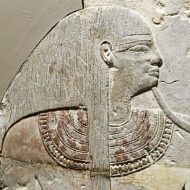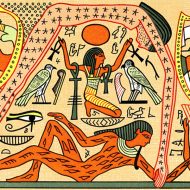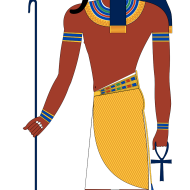Geb : God of the Earth
Listen
Geb
Introduction
The Egyptian god of the earth, also known as Geb, was a mythological figure from the Ennead of Heliopolis. In ancient Egypt, it was believed that his laughter would cause earthquakes and that he helped with the growth of crops. He was regarded as the world’s physical support.
The second generation of the Ennead, Geb and his sister Nut, were represented in Egyptian art as the Earth’s two deities. In some works, the pair were depicted lying on the ground, with the air god Shu and the goddess of the sky, Nut, standing above them. Geb was also sometimes depicted as a man with no distinguishing features, but his head was sometimes shown to be surmounted by a goose.
Physical Traits
As a fertility deity, Geb was typically depicted as a man with green skin, and his body was often adorned with hieroglyphs and plants. He was often placed beneath his wife, who was referred to as Nut, and his genitals were pointed in her direction. Geb was often depicted wearing a red crown or a goose hieroglyph on his head when he was standing. His name was embroidered on the hieroglyph and was usually represented by a goose.
Family
Geb was a part of the third Egyptian god’s generation, and his parents, who were Tefnut and Shu, are the offspring of Ra. With his sister, Nut, he also had the likes of Isis, Nephthys, and Osiris. Because of this, the pharaohs believed that they were related to Geb.
When Geb and Nut were born, they held each other so tightly that Nut could not give birth. Eventually, their father Shu forced them apart to allow the next generation of gods to be born. This myth explained how the earth and sky became separated.
Other names
The pronunciation and spelling of Geb’s name have been the subject of much debate. Sir E.A. Budge, an Egyptologist, referred to him as Seb, while Heinrich Brugsch called him Keb. Geb is commonly used today, though some sources still refer to him as Seb.
Powers and Abilities
Geb was often associated with earthquakes and the underworld, and some believe that he had the power to control snakes living in the earth. He was also regarded for his ability to heal wounds. He was often linked to kingship, and the Egyptian throne was referred to as the seat of Geb.
Modern Day Influence
Geb was also regarded as the father of various Greek gods, such as Zeus and Hades and equated to Cronus, in Greco-Roman Egypt. He was seen as a similar deity to Cronus, and this was well-known in Tebtuni in the southern Fayyyum. This was a local variation of the cult of the crocodile god Sobek.
In the movie The Mummy, which came out in 1999, Geb was one of the gods who were invoked by Imhotep to cause the ten plagues of Egypt. In the video game Age Of Mythology, which came out in 2002, he can be worshipped as a minor deity. He can grant bonuses to building and farming, and he can also summon a sandstorm.
Rick Riordan’s The Kane Chronicles, which was released from 2010 to 2012, featured a depiction of Geb as a god who can be utilized by magicians. He is shown as a laid-back god who enjoys making fun of others and playing with his pet snakes.
Related Images
Frequently Asked Questions
What is lorem Ipsum?
I am text block. Click edit button to change this text. Lorem ipsum dolor sit amet, consectetur adipiscing elit. Ut elit tellus, luctus nec ullamcorper mattis, pulvinar dapibus leo.
What is lorem Ipsum?
I am text block. Click edit button to change this text. Lorem ipsum dolor sit amet, consectetur adipiscing elit. Ut elit tellus, luctus nec ullamcorper mattis, pulvinar dapibus leo.
What is lorem Ipsum?
I am text block. Click edit button to change this text. Lorem ipsum dolor sit amet, consectetur adipiscing elit. Ut elit tellus, luctus nec ullamcorper mattis, pulvinar dapibus leo.
What is lorem Ipsum?
I am text block. Click edit button to change this text. Lorem ipsum dolor sit amet, consectetur adipiscing elit. Ut elit tellus, luctus nec ullamcorper mattis, pulvinar dapibus leo.
What is lorem Ipsum?
I am text block. Click edit button to change this text. Lorem ipsum dolor sit amet, consectetur adipiscing elit. Ut elit tellus, luctus nec ullamcorper mattis, pulvinar dapibus leo.










